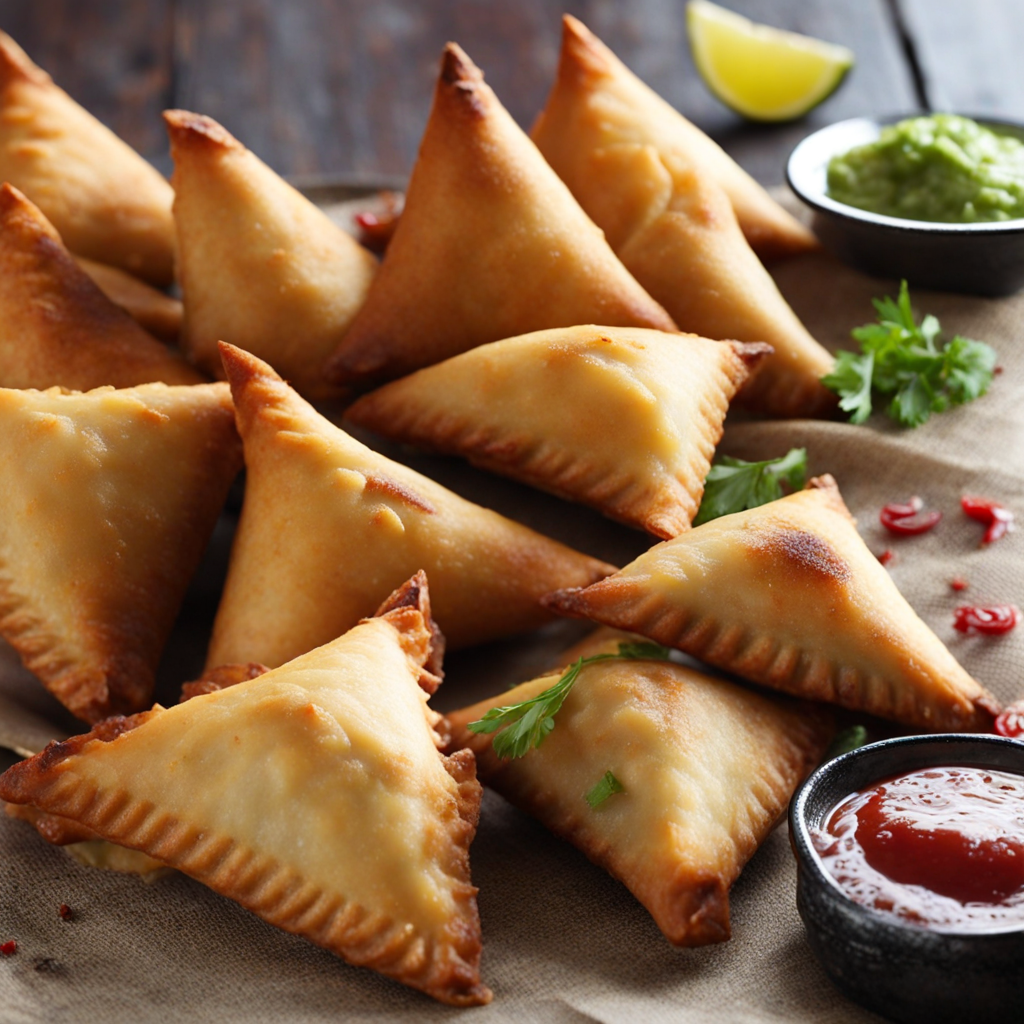Samosas
Samosas from Mauritius are a delightful fusion of flavors and textures, showcasing the island's rich culinary heritage. These deep-fried pastries are typically triangular in shape, with a crispy, golden-brown exterior that gives way to a savory filling. The dough is made from a simple blend of flour and water, rolled out thin and expertly folded to create a pocket for the delicious filling, which can vary widely but often includes spiced potatoes, peas, and sometimes minced meat or lentils. The use of local spices, such as cumin, coriander, and turmeric, infuses the filling with warmth and depth, making each bite a burst of flavor.
How It Became This Dish
The History of Samosas in Mauritius Samosas, those delightful, crispy pastries filled with spiced potatoes, peas, or meat, have a rich and multifaceted history that is deeply intertwined with the culture and culinary landscape of Mauritius. This small island nation in the Indian Ocean is a melting pot of cultures, and the samosa serves as a perfect reflection of this diversity. #### Origins of the Samosa The samosa's origins can be traced back to the Middle East and South Asia, where it is believed to have emerged around the 10th century. The earliest known mention of a samosa-like dish appears in the writings of the Persian poet, Abul Hasan Ali ibn al-Husayn Mas'udi, who described a fried pastry filled with meat. From Persia, the concept of the samosa spread to the Indian subcontinent, where it was adapted to local tastes and ingredients. In India, the samosa became a popular street food, often filled with spiced potatoes, green peas, and sometimes minced meat. By the time it reached the Indian subcontinent, it had evolved into a variety of shapes and fillings, each region putting its own spin on the classic recipe. #### The Journey to Mauritius Mauritius, with its strategic location along trade routes, has historically been a crossroads of various cultures, including Indian, African, Chinese, and European influences. The arrival of Indian indentured laborers in the 19th century played a significant role in the introduction and popularization of the samosa in Mauritian cuisine. These laborers, who were brought to the island to work on sugar plantations after the abolition of slavery, brought with them their culinary traditions, including the samosa. Initially prepared as a comfort food during their arduous labor, the samosa quickly became a staple among both the Indian community and the broader Mauritian society. #### Cultural Significance In Mauritius, samosas are more than just a snack; they embody the island's rich tapestry of cultural influences. They are often enjoyed during festivals, celebrations, and family gatherings. The samosa's versatility allows it to be served as a starter, a snack, or even as part of a larger meal. The Mauritian samosa stands out due to its unique fillings and flavors. While traditional potato and pea fillings are still common, local variations include fish, chicken, and even chutneys that reflect the island’s diverse culinary influences. The samosa is often accompanied by a side of chili or tamarind sauce, which adds an extra layer of flavor that speaks to the Mauritian love for bold tastes. #### Evolution Over Time As Mauritius has evolved, so too has the samosa. In the late 20th century, the island saw an increase in tourism and globalization, which introduced new culinary trends and ingredients. The samosa adapted once again, with local chefs experimenting with fusion recipes that incorporated elements from other cuisines—like the addition of cheese, seafood, or even local herbs and spices. Moreover, samosas have become a symbol of Mauritian identity, often featured in culinary festivals and competitions that celebrate the island's multicultural heritage. The emergence of gourmet samosas has also taken the food scene by storm, with upscale restaurants and food trucks offering artisanal versions that showcase high-quality ingredients and innovative flavors. #### A Culinary Icon Today, the samosa is a beloved culinary icon in Mauritius. Its presence is felt in local markets, roadside stalls, and restaurants, where vendors often serve them hot and fresh, making it a popular snack for both locals and tourists. Street food culture has flourished in Mauritius, and samosas are a staple item on many menus, often enjoyed with a cold beverage. The samosa is not only a culinary delight but also a symbol of resilience and adaptation. It has survived the tests of time and has been embraced by various communities, each adding their unique touch to this humble pastry. The samosa also represents the fusion of flavors and cultures that define Mauritius, making it a perfect embodiment of the island's spirit. #### Conclusion The history of samosas in Mauritius is a testament to the island’s rich cultural heritage and its ability to embrace and adapt culinary traditions. From its origins in the Middle East and South Asia to its current status as a beloved snack, the samosa has evolved while retaining the essence of its roots. As Mauritius continues to develop as a culinary destination, the samosa will undoubtedly remain a cherished food item, celebrated for its flavor, versatility, and cultural significance. Whether enjoyed at a bustling street stall or at a family gathering, the samosa is more than just a pastry; it is a delicious narrative of the island’s history and the people who inhabit it.
You may like
Discover local flavors from Mauritius







